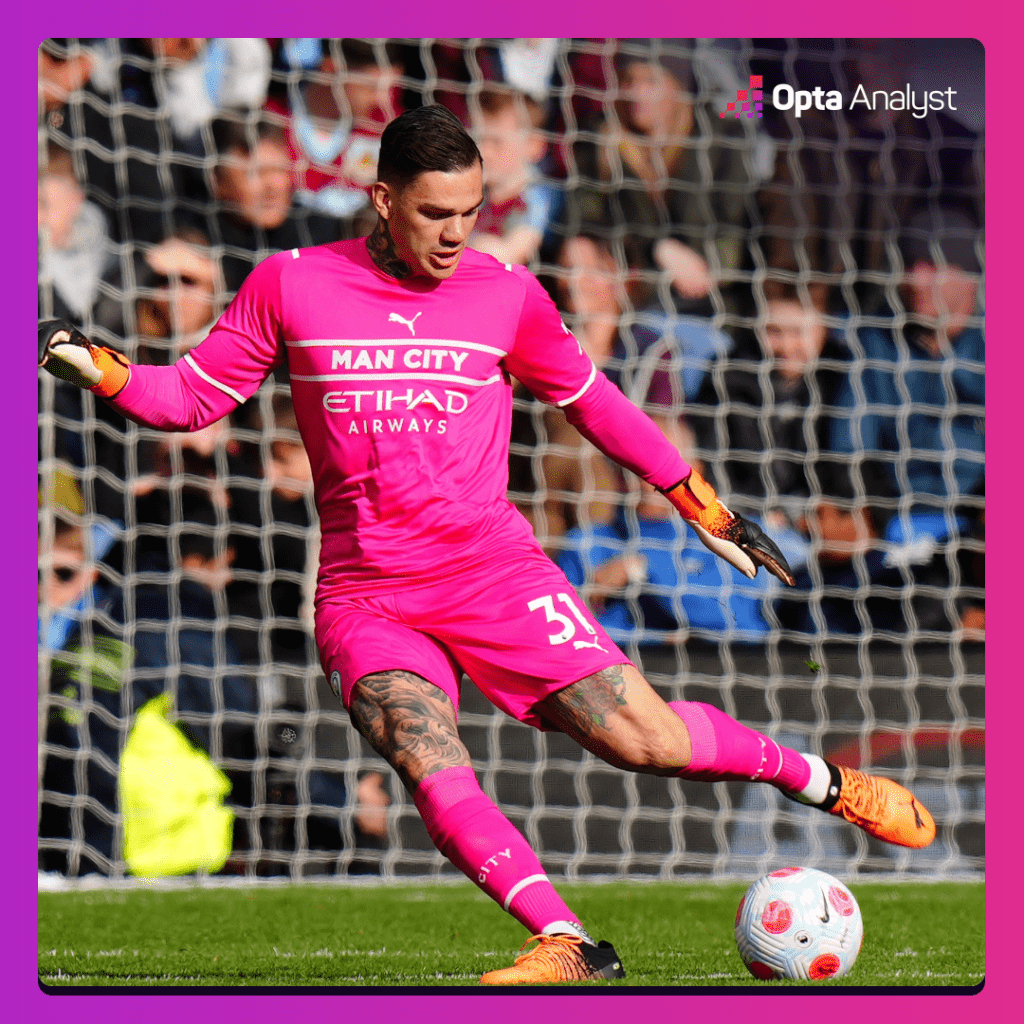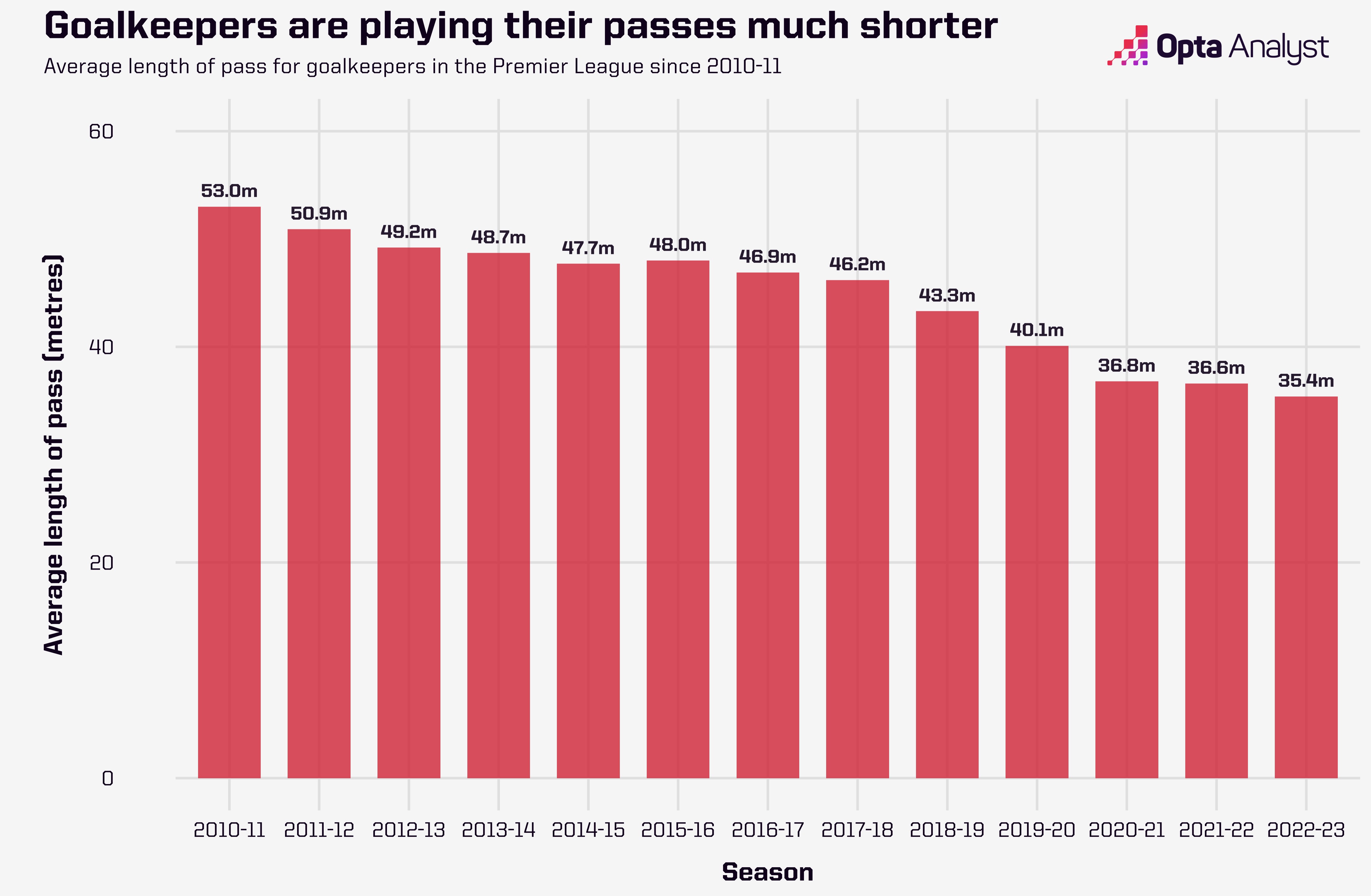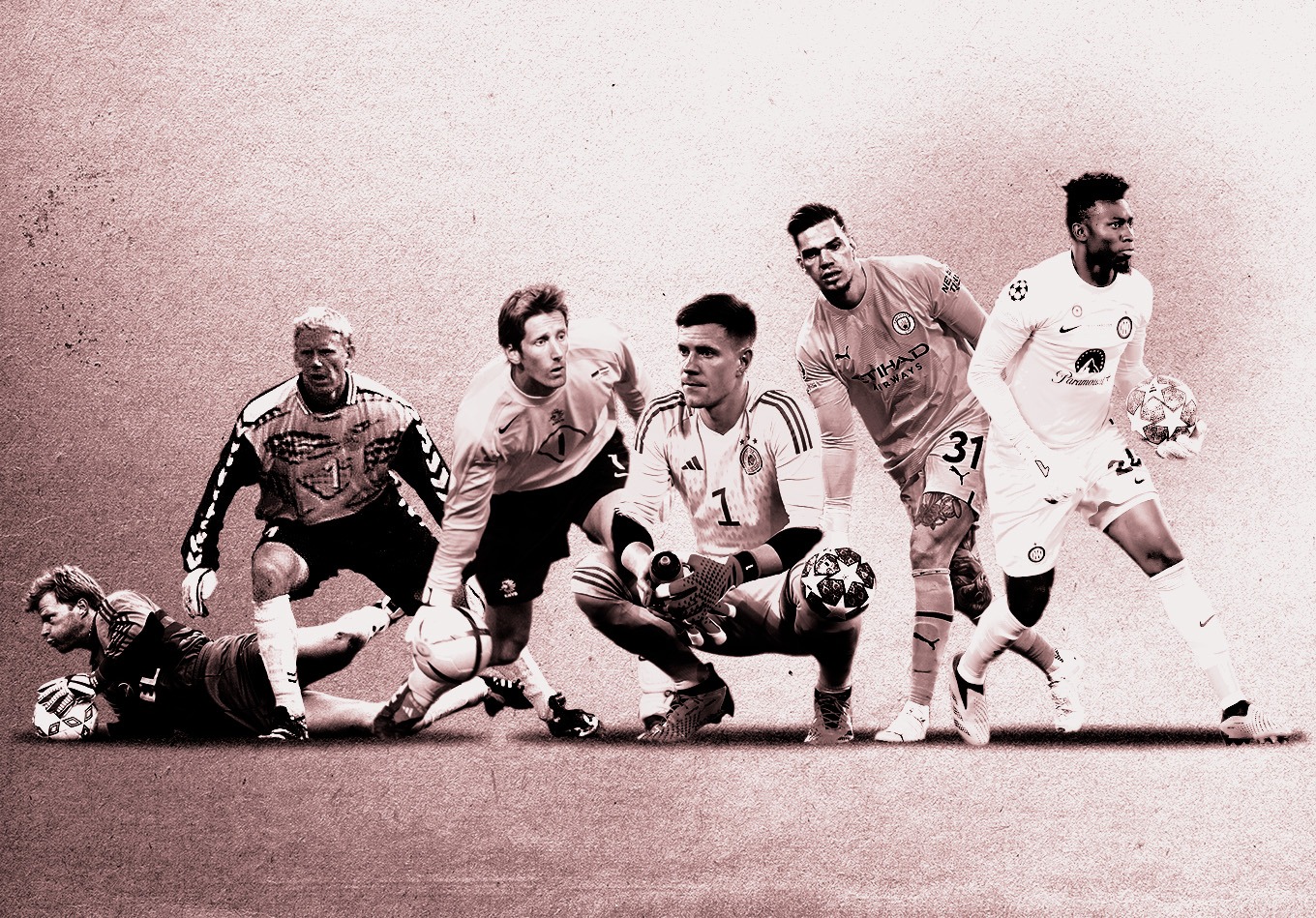No longer is the goalkeeper just the 11th player; they’re now a defacto 11th outfielder.
It may always look like the same sport to the naked eye, but football is constantly evolving. No, we don’t mean the shape of the ball, or the goal for that matter. Tactical trends come and go as coaches and managers seek the marginal gains that can transform a poor team into a good one, or a great team into the best.
One of the most significant shifts this century has related to goalkeepers. Once, they were arguably seen as little more than the person who attempts to keep the ball out of the net and then hoofs it up the other end, as far away from danger as possible.
Now, however, the position feels like it has more influence on outfield matters by the year, and more so than ever before. No longer are goalkeepers just the last line of defence:
“My club has a very strong idea of using a goalkeeper as the 11th outfield player,” Fabian Otte, first-team goalkeeper coach at Borussia Mönchengladbach tells Opta Analyst, and the proof is in the numbers. Last season, the Bundesliga keepers with the most touches in single matches were those of Gladbach (Yann Sommer with 101 vs. Freiburg, and Jonas Omlin with 96 vs. Köln).
And it makes sense. Why wouldn’t you try to maximise the in-possession efficiency of your team by ensuring all 11 players – not just the 10 outfielders – are perfectly comfortable on the ball? If possession dominance is your aim, having a goalkeeper who’s assured with the ball at their feet seems logical.
But these days there’s another element to consider: pressing. It’s certainly not a new tactic; in ice hockey, a comparable strategy called ‘the trap’ is rooted in the 1930s, while in football (soccer) both Viktor Maslov and Ernst Happel have been considered ‘fathers of pressing’ for their respective exploits in the 1960s and 1970s.
However, pressing is now in its heyday. The “high turnover” is a statistical metric you’ll see noted on live football broadcasts by the likes of Sky Sports, highlighting how the prevalence of the strategy has brought the term into almost everyday football vernacular. It wasn’t like this 10 years ago.
Most (all?) clubs in Europe’s top leagues implement pressing tactics in one way or another, but it’s not flawless. Having a brave (not bonkers) goalkeeper who’s an excellent passer – like Ederson or André Onana, for example – can help teams play through or around a high press, potentially taking several opponents out of the game very quickly while simultaneously springing a fresh attack.
But this iteration of the goalkeeper doesn’t fit the ‘traditional’ model. “In the 1990s, it was the era of Peter Schmeichel and Oliver Kahn, guys that were incredibly big and strong and especially good at keeping balls out of the net. But, in attack they offered almost nothing,” legendary Dutch goalkeeper coach Frans Hoek – known for working closely with Johan Cruyff – told The Athletic in 2020.
If you played youth football pre-2013, think back and consider how many of your technically gifted peers wanted to play in goal when aged 12 or 13… And then how many of those were also really good in goal? For most people, it was probably quite common for the goalkeeper position to be an afterthought, or to be imposed on the boy or girl who hadn’t developed much technique.
Granted, these are anecdotal generalisations that aren’t rooted in scientific or numerical proof, but many people will recognise or remember similar scenarios. So, how, and why have things changed? How do we create more goalkeepers like Ederson?

Before we get to those questions, though, you’re potentially pondering how we really know the goalkeeper role has evolved. Yes, we all probably think it has, but is it just confirmation bias? Where’s the evidence?
Well, we looked at passing data for goalkeepers who played at least 1,000 minutes across a season in the top five leagues going back to the start of the 2007-08 campaign, and the findings confirmed our suspicions.
Each league has seen the average passing accuracy of goalkeepers increase by at least 13 percentage points; the biggest improvement came in Serie A, where the completion rate has gone up from 51% to 69.7% in 2022-23, though La Liga (46.9% in 2007-08 to 65.4% last term) wasn’t far behind in those stakes.
It’s a similar story with respect to the percentage of goalkeepers’ passes remaining in their own half. In 2007-08, on average only 23.3% of keepers’ passes ended before the halfway line in the Premier League, which was the smallest such share across the top leagues; the Bundesliga (37.4%) had the largest share.
But last season, La Liga (57.2%) was the only one of the big five to be below 61.7% (Premier League). Each of these competitions has also seen goal-kick accuracy increase by at least 11 percentage points, while England’s top tier’s gone up by 23.2, a consequence of keepers being more considered in their distribution and fewer simply lumping the ball as far as they can when restarting play.
Goalkeepers are playing shorter passes between two and three times as often as they were 16 years ago, highlighting a real shift in distribution habits at the elite level.
So, back to the how and why of it all.
Obviously, every player’s journey is different, but clearly youth development plays a massive role here. Using Ederson as the case in point, the story goes that he was actually an attack-minded left-back as a child but became a goalkeeper because he was – in his own words – too “lazy” to thrive outfield. So, although he began focusing on a new position, he’d already banked the technical abilities he needed playing out of goal.
“This is just my opinion, but it’s also one reason why at the very young age of youth development we shouldn’t fixate on certain positions too early,” Fabian Otte says. “For me, at under-9s, under-10s, under-11s, there shouldn’t be one fixed goalkeeper, everyone should be a goalkeeper at times and everyone should be an outfield player so kids learn to develop these skills without really thinking about it, just by playing football, having lots of touches on the ball.”
This echoes the belief of visionary Hoek, who, in the same interview mentioned before, said: “You don’t need to be a goalkeeper when you’re six years old”. Such early focus can be severely limiting; Ederson may not have made it as a professional had he continued on his previous trajectory, yet he’s now one of the world’s best-regarded goalkeepers because he broadened his horizons.
Linked to all of it is the coaching, which has become more immersive and meticulous, as Fabian adds: “I think [young goalkeepers] are definitely more used to [seeing more of the ball] because coaches in academies these days like to use goalkeepers in their build-up as well, so from very young and early stages, goalkeepers learn to play with their feet and then be involved in team sessions with these elements integrated; like, how do I play around in a 4-vs-3 situation like playing out of a press? So, I definitely think there’s been some development in training over the years, especially in the academy space.”
Aidan Reagh also feels a corner’s been turned in that respect, noticing a wider appreciation and adoption of new methods in his role as a technical analyst, scout and coach who focuses mostly on goalkeepers from grassroots level to professional. “Even 10 years ago with sweeper keepers becoming more popular, we started seeing youth goalkeepers having more training, and drills coming out in the coaching curriculum training that intercepting, training that one-on-one ability, and now we’re starting to see the ball-playing. So, I do think it’s changing.”
In fact, USA-based Aidan already thinks most goalkeepers aged between 18 and 21 that he now sees profile much closer to the archetypal “ball-playing goalkeeper” than anything else. They may not be that quite to the extent of Ederson, or Onana, but their strengths at least put them in that category, and there’s a feeling this provides goalkeepers with a better chance of ‘making it’ at a professional level.
“As you know, it’s very rare for one-club players to happen,” Aidan continues. “It’s typical [that a player will] move on from the academy, either up or down. As more and more teams are looking for that technically gifted player on the ball, [not being comfortable with the ball at your feet] is going to limit the players who might be absolutely fantastic shot-stoppers, they might be incredible at reading play and coming off the line, but when you have fewer teams looking for that type of player, it naturally limits what you can do.”

“I really don’t think City would’ve signed Ederson if he was only a ball-playing goalkeeper,” Fabian says with a smile, and it’s a salient point. Let’s not forget, these players are still goalkeepers first and foremost. “You have to be able to do everything as a goalkeeper. A goalkeeper must be good in goal, that’s the main task.”
After all, in the Premier League for example, over the time span we studied for passes, there’s not been a huge reduction in saves; keepers were tested 3.05 times per 90 minutes in 2007-08, and last season it was 2.90. A very slight decrease, yes, but the need to be an able shot-stopper remains.
And there’s also more to being a good ball-playing goalkeeper than just picking a pass. Strictly speaking, pretty much all top-level goalkeepers have some technical ability; they’re professional footballers. In a static training-ground situation whereby they’re asked to ping a 40-yard pass to a target or marker, they’d be far better than you or I.
This is a point Fabian emphasises and one that highlights actually how difficult it is to be a world-class ball-playing goalkeeper. You might think about a well-placed 30-yard pass, or a sliced drop-kick, but in reality, the kick is just one factor.
“You have to see the big picture,” he says. “It’s your position; are you close to your centre-backs? Do you create space and drop deeper? What angle do you position yourself in to receive the ball? Then it’s a lot about information perception and decision making; what do I perceive? How many attackers are pressing me: one, two or three? How do they mark the midfielders behind the attackers? Is it man-marked or space-marked? Do I have to kick over the backline of the opponent because they step really high and there’s lots of space at the back? Then finally you have the distribution part of kicking the ball and passing it.”
Team training and integrating these scenarios into match-like sessions is the key, and Fabian feels academies are generally doing a “really good job” of making goalkeeper training fit seamlessly into broader drills, thus helping to maximise the player’s reliability and information perception under pressure.
Don’t expect this to turn out to just be part of a phase, either. Aidan’s adamant the likes of Ederson, Alisson, Ter Stegen and Onana will have inspired a “generation”, and so it’s only natural that more and more goalkeepers will break into senior-level football with well-rounded technical skills as well as goalkeeper-unique strengths; in fact, our data shows this is already happening. Fabian “100%” agrees, with this seemingly just the start of a new era for goalkeeping.
It’s time to shape up or ship out; just ask David de Gea.
Enjoy this? Subscribe to our mailing list to receive exclusive weekly content. And follow us on Twitter too.
